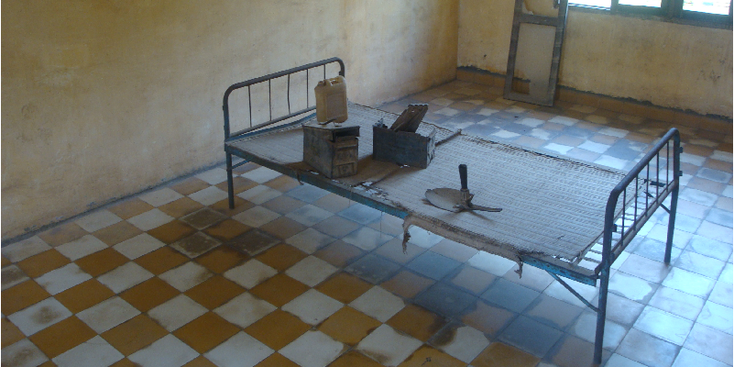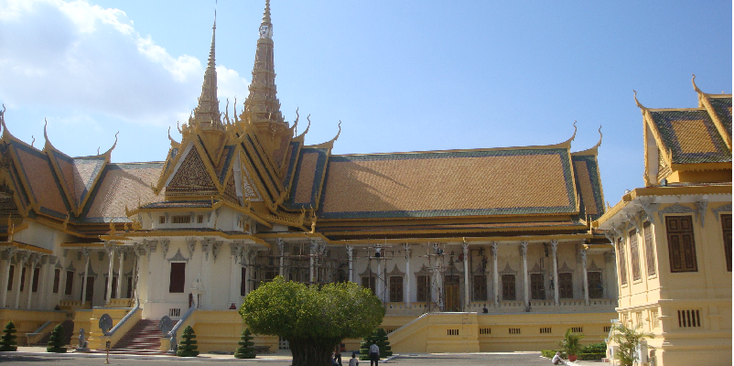Phnom Penh
Places of Interest - Cambodia


introduction
The capital of Cambodia, located in the southeast of the country at the confluence of the Mekong and Tonle Sap rivers, is also the largest and most important city in the country. Once known as the pearl of Asia, the city has a very interesting and eventful history with the colonization of France, the Vietnam- and civil war and the "Khmer" Revolution. Today it is a chaotic busy but pleasant city to stay in.
A mix of modern and old, European and Asian with a lot of culture. You can snif in history at the notorious former Tuol Sleng prison and the Killing Fields but also the Royal palace. Small noisy mopeds tear past, you can experience "girlie" bars but also rows of Buddhist monks, temples but also mosques are you part in a visit to Phnom Penh. There are a number of interesting museums, colonial architecture but also markets and an evening at a large open-terrain restaurant with the locals is a unique experience.
Atmospheric, chaotic, interesting and a city that wants to move forward, forgetting the (dark) past.
highlights

Royal palace and the silver pagoda:
The Royal Palace is located near the river hidden behind a high stone wall. It is a similar palace as you can see in neighbouring capitalcity Bangkok (in Thailand) but much smaller, more intimate but still a very impressive complex with its golden roofs. The central hall, once belonging to King Sihamoni may unfortunately not be entered. This is only used for any ceremonial event.
The royal family still exists but has no longer any actual (political) power. The silver pagoda next to the hall may be entered. This exists as the name suggests from 5000 silver tiles. To the left of the large hall there is a small museum with utensils and clothing that were used for large receipts by the Royals. Unfortunately, many Royalties were destroyed by the Khmer Rouge regime in the seventies and eighties.
Behind the large hall is a small collection of old cars that were used by the then King. You can also take a look in the lovely quiet gardens that have been created around the palace.

Killing Fields Choeung Ek
Choeung Ek, is an agricultural area about 14 km south of Phnom Penh in an orchard. Prisoners from the former prison Tuol Sleng in Phnom Penh were brought here and killed. To save bullets, the Khmer Rouge killed children by hurling them against trees or by killing them with kicking their heads with the back of their guns. Death bleeding was also widely used.
At least 20,000 people were killed here between 1975 and 1979. Choeung Ek was only one of the many killing fields (fields of death) in Cambodia. In a monument, a white tower with glass windows, are many skulls sorted by children/ adults and man/woman. Some graves are only half excavated and one can see the remains of people and clothing lying in them.
It is not recommended to visit this museum with young children and also by adults who are quickly emotional. A visit to these fields and to the Tuol Sleng Museum often makes a very insistent impression on people. Every year there will be a memorial service for the victims on 9 May.
>>> Tuol Sleng museum (see museums).
Other attractions:
- The National Museum of Cambodia, the central market Psar Thei and/or the Independence Monument and Wat Phnom.

history
No matter how Phnom Penh originated, it became the capital of Cambodia for the first time after King Ponhea Yat of the Khmer Empire fled from Angkor Thom, after it was conquered by the kingdom of Ayutthaya in 1431. A strategic location was chosen for, among other things, trade, in the middle of the country along the Mekong and the Tonle Sap rivers.
But the real growth did not begin until the King Norodom I and his government actually started living in the capital and reinforced that growth when the French dug around the city channels for the drainage of the many marshes and roads and built a harbor. Also then the Royal Palace was built and not much later also the Silver Pagoda. This started the growth of Phnom Penh into a real important and big city. When the French arrived in 1863, the city was essentially liberated from the great neighbouring powers of Vietnam and Thailand.

By the 1920s, Phnom Penh was known as the Pearl of Asia. The city continued to grow due to the construction of a railway line and the “Pochentong” airport. The French left the city in 1953 and the city continued to grow under Sihanouk's Crown.
During the Vietnam War many many fighting happend in neighbouring Cambodia. The United States bombed the countryside because of the (in)famous Ho Chi Minh City and retreating Communist soldiers of North-Vietnam. As a result, many refugees traveled to the city. In 1975, the population had risen to more than 2 million inhabitants. On April 17, the Cambodian New Year, the city fell and was occupied by soldiers of the Khmer Rouge.
The city was then completely cleared with a hard hand. The residents were sent to farms in the countryside to be rehabilitated. Some 50,000 people stayed behind. The "Tuol Svay Prey" college was changed to the notorious Tuol Sleng prison (S-21). This prison is now the Tuol Sleng museum and, like Choeung Ek, is a reminder of those killed by the Khmer Rouge. The Khmer Rouge were expelled from Phnom Penh by the Vietnamese in the beginning of 1979. The people then began to return to their homes.
But it took years before the city blossomed again, causing the murder of almost all intellectuals by the Khmer Rouge. A period of reconstruction started that first slowly went through the political instability in the country.

tips & advice (2009)

Phnom Penh has an (international) airport about 7 km west of the city center. There seems to be a train station but transport by bus is preferred. Because PP does not have a real bus station, different buses leave from different bus companies (and places). Most can be found near Psar Thmei and on the north side of Sisowath Quay. Local buses are not present in the capital; you will have to transport yourself with "motos" or "cyclos".
PP - Sihanoukville: this bus journey takes about 4 hours and costs around 19.000 Riel. There is definitely a bus at 07:15. Bus companies Capital Transport, GTS and also Hua Lian depart from PP to Sihanoukville.
PP - Ban Lung: this bus trip takes about 12 hours. Costs are about $ 17.50 and there is only one bus per day.

-
Name: Tuol Sleng museum (or museum of the genocide)
Address: Street 113
Price: $ 2
Time: 08:00 - 17:30
Content:
The museum is located in the same building where the Khmer Rouge tortured and killed his prisoners in their infamous prison. In the museum thousands of photos of victims of the Khmer Rouge and also a map of Cambodia were made with the skulls of the victims. At the liberation of Phnom Penh in 1979, the Vietnamese only found seven survivors here. Many prisoners (victims) were buried in the garden.
What this museum often gives an extra pushy feeling is that it is located in an ordinary former school building. It is not recommended to visit this museum with young children and also by adults who are quickly emotional. A visit to this museum and Choeung Ek (Killing Fields) often makes a very strong impression on people. A very interesting film is also shown.


When it’s dark and dinner time, hundreds of tables are dragged outside on a large square near my hostel (see below) before Psar O'Russei; cozy, attractive, tasty and very cheap food in a unique place. Also at the intersection of street "Street 182" and "Street 107" is a perfect restaurant with a beautiful view of the intersection and the street life.
Many expats, (Western) tourists come here.

-
Name: Hostel Prehmaen
Address: Street 107
Price: $ 5 (single)
Content:
This hostel was not in the booklets and I found it by accident. It is located near the (tourist) center on walking distance from the Silver pagoda but certainly on that of Tuol Sleng. It is located in a busy street but I had a big room in the attic where it is quite.
You have your own shower and toilet but do not expect anything more - it is not atmospheric, there are no common areas or whatever. The room is large but there is nothing else in it - it is reasonably clean. So to meet other tourists or whatever, this is not the right hostel.

see also:
LANDEN:
EUROPA:
Albanië * België * Bosnië-Herzegovina * Bulgarije * Denemarken * Duitsland * Engeland * Estland * Finland * Frankrijk * Griekenland * Hongarije * (Noord) Ierland * Italië * Kosovo * Kroatië * Letland * Litouwen * Luxemburg * Macedonië * Malta * Montenegro * NEDERLAND * Oekraïne * Oostenrijk * Polen * Portugal * Roemenië * Rusland * Schotland * Servië * Slovenië * Slowakije * Spanje * Tsjechië * Turkije * Zweden
NOORD EN CENTRAAL-AMERIKA:
Chili * Costa Rica * Cuba * Guatemala * Mexico * Nicaragua * Panama * Verenigde Staten
ZUID-AMERIKA:
Argentinië * Bolivia * Brazilië * Colombia * Ecuador * Peru
AFRIKA:
Botswana * Burkina Faso * Egypte * Ethiopië * Ghana * Kenia * Mali * Marokko * Namibië * Oeganda * Senegal * Tanzania * Tunesië * Zuid-Afrika
MIDDEN-OOSTEN:
Iran * Israël * Jordanië * V.A.E.
AZIE:
Armenië * Cambodja * China * Filipijnen * Georgië * India * Indonesië * Japan * Kirgizië * Laos * Maleisië * Mongolië * Myanmar * Nepal * Oezbekistan * Singapore * Sri Lanka * Thailand * Vietnam
OCEANIE:
Voor meer reisfoto's kijk op www.instagram.com/cheapskatetravel.nl:
© Cheapskatetravel.nl; 2018 (all rights reserved)



